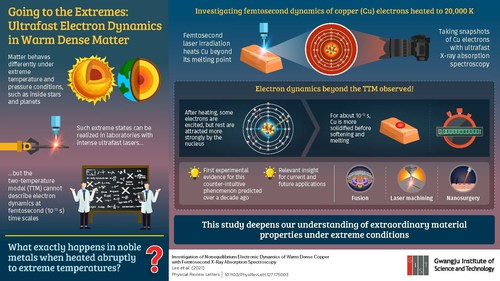GWANGJU, South Korea, Jan. 10, 2022 /PRNewswire/ — Intense laser pulses lasting only femtoseconds (10-15 s) can create extreme states of matter usually found inside planets and stars. Conventional physical models, however, are unable to describe the electron dynamics in such states. Scientists from the Gwangju Institute of Science and Technology in Korea have now explored non-equilibrium dynamics in copper electrons heated to temperatures over 20,000 K, presenting findings that may open new doors for fusion, laser cutting, and nanosurgery.
Ordinary matter behaves very differently when subjected to extreme temperatures and pressures, such as that inside stellar and planetary cores. Conventional rules of condensed matter physics and plasma physics are not applicable in such scenarios. In particular, an extreme state known as "warm dense matter" (WDM) straddles the boundary of condensed matter physics and plasma physics.
One might think that such states can never be created in a terrestrial setting. But, in fact, short laser pulses that are only femtoseconds (10-15 s, or a quadrillionth of a second) long are intense enough to recreate such conditions in a laboratory! Conventional physical models that describe such states typically assume that electrons excited by the laser pulse attain equilibrium within tens of femtoseconds while the ions remain "cold." However, in doing so, the non-equilibrium dynamics of the electrons are completely disregarded.
To explore this non-equilibrium dynamics under extreme conditions, a team of researchers led by Associate Professor Byoung Ick Cho from the Gwangju Institute of Science and Technology in Korea studied the WDM state for copper created by using intense laser pulses. The optical pulse excitation created copper electrons with a temperature ~ 20,000 K, which is similar to that of a giant planet’s core. Then, right when the copper sample was about to melt, the researchers took snapshots of the electrons using ultrafast x-ray pulses from an x-ray free electron laser (XFEL). This allowed them to analyze what happens in noble metals, such as copper, when their bonding electrons are highly excited and the metals are about to melt. The results of the study were published in Physical Review Letters.
One remarkable observation was that, when heated quickly, the bonds between copper atoms first hardened for about one trillionth of a second (10−12 s) before melting. Put simply, the sample solidified before turning into liquid! The team carried out detailed theoretical analysis backed by simulations, which revealed that while some electrons were excited to higher energies at such high temperatures, some experienced a stronger attraction towards the nucleus. "This phenomenon was, in fact, predicted about a decade ago, but we have now managed to observe it directly for the first time," comments Prof. Cho. "This can improve our understanding of extraordinary material properties under extreme conditions and their underlying mechanisms."
These findings could be applied in contexts where materials are subjected to extremely high pressures and temperatures. "By capturing the precise moment when a material starts to melt or vaporize, we can generate new phases of matter or energy, which would be relevant to fields such as fusion, laser machining, and even nanosurgery," speculates Prof. Cho.
Who would‘ve thought that understanding the interior of stars could have such practical terrestrial applications?
Reference
Title of original paper: Investigation of Nonequilibrium Electronic Dynamics of Warm Dense Copper with Femtosecond X-Ray Absorption Spectroscopy
Journal: Physical Review Letters
DOI: https://doi.org/10.1103/PhysRevLett.127.175003
About the Gwangju Institute of Science and Technology (GIST)
Website: http://www.gist.ac.kr/
Corresponding author‘s email:
327155@email4pr.com
Media contact:
Seulhye Kim
327155@email4pr.com
82 62 715 6253
SOURCE Gwangju Institute of Science and Technology


